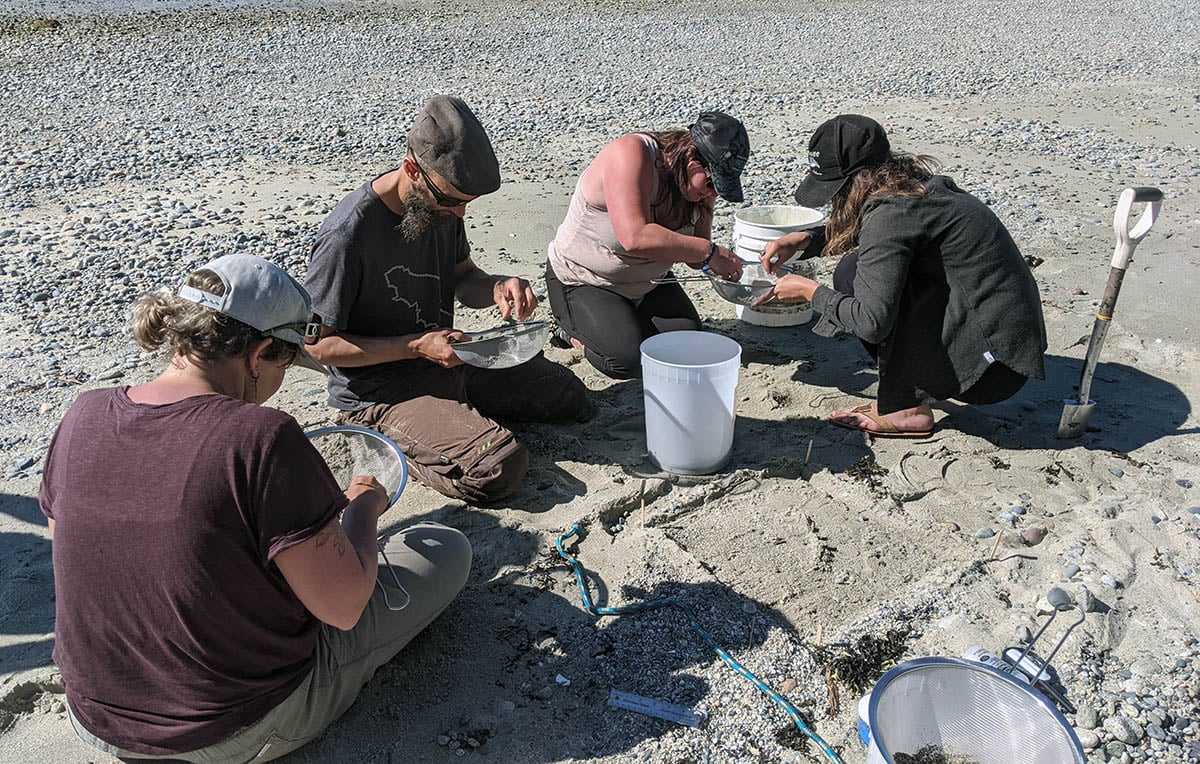qathet Community Use Ocean Diagnostics Tools and Technology to Uncover Regional Microplastic Pollution Sources
Growing up along Canada’s western Pacific coastline, Abby McLennan developed a deep relationship to what she calls a “magical ecosystem.” Now residing among the traditional territories of the Tla’amin, shíshálh, Klahoose, Nanoose, and K’ómoks First Nations in British Columbia’s qathet region, McLennan has an even deeper appreciation for the myriad of marine and plant biodiversity that make the area so unique.
Seeing these otherwise pristine and remote beaches become riddled with plastic pollution motivated her not only to act, but to tackle the root of the problem. McLennan’s organization Let’s Talk Trash mobilizes community volunteers to conduct routine microplastics surveys of five regional beaches to identify sources and solutions and help to measure their long-term impact. Now in their second year of surveying, these community scientists have helped to identify expanded polystyrene (EPS) beads as the most abundant microplastic type in the region and link their source to aquaculture and dock infrastructure.
“Participating in microplastic sampling and data collection is one way I feel that I can impact policy change,” she explains.
Microplastics are tiny pieces of plastic smaller than 5 mm (about 0.2 inches) in size. They include pre-production nurdles used to produce plastic items or fragments of larger plastic items that break down over time, including car tires, packaging, clothing fibres, fishing gear, to name a few. Microplastics enter the environment through our households, cities, coasts, agricultural lands and industries, primarily through treatment plants, city stormwater sewers, runoff and mismanaged waste. When exposed to microplastic pollution, ecosystems and species integral to the area’s cultural preservation, food security and local economy could be at risk.
“By participating in microplastic sampling, community members start to observe the problem affecting their areas and become inspired to protect our collective waterbodies through research, support and knowledge,” shares McLennan.
To stop microplastics from entering the environment, decision makers need more scientific data on the sources, fate and impacts of environmental microplastics. Community or citizen scientists can help to fill these data gaps. Working with local organizations like the Tla'amin Watchmen program and School District 47, Let’s Talk Trash has added this important data collection piece to its existing cleanup initiatives to include reliable data in its reports.
“Knowing there are other folks out there doing the same thing helps keep our fire and drive for positive change going,” McLennan explains.

Using Ocean Diagnostics’ Microplastics Community Science Toolkit, participants follow a standardized beach sampling protocol to collect a representative sample of visible microplastics, then image the particles with AI-based technology called the Saturna Imaging System to generate a robust set of size, shape, colour, type and abundance data. This information provides important clues on the sources and impacts of local microplastic pollution and, in turn, helps to identify solutions. Saturna accelerates the data analysis process and reduces human error in data reporting to ensure reliable, accurate and reproducible results. The data is uploaded from Saturna to a web portal called Mariana where it is added to a global dataset to show microplastic hot spots.
“I enjoy teaching others how to conduct these surveys to spread awareness,” says McLennan, “I hope it recruits more change makers in this space and leads to more people picking up debris every time they venture out to a shoreline, wherever in the world they may be."
The five survey sites included in this project were strategically selected to ensure proper scientific controls. For example, McNair Road is a beach that, based on its west-facing location, should be very clean in theory, while Second Beach has high urban use and is situated near a wastewater treatment outflow. Ahgykson is an uninhabited but culturally significant island to the Tla'amin Nation but, due to its orientation, acts as a major catchment for marine debris throughout the winter storm season. Savary Island adds a south-facing beach to the test sites, while toxʷnač (Okeover Inlet) is known to be a hot spot for EPS bead accumulation and source point for marine debris as the inlet has a high concentration of aquaculture farms.
“This work reinforces the fact that plastic pollution is a problem, even in my seemingly pristine part of the world,” iterates McLennan, “which motivates me to continue addressing the root cause through a variety of ways, from grassroots initiatives to providing feedback on policy intention papers and lobbying different levels of government.”
Despite their unique placements, all survey beach sites show a high abundance of EPS beads, with plastic line filament as the next most common microplastic type. With regular surveys, McLennan hopes to illustrate the presence of plastic pollution in a seemingly untouched region and provide a solid baseline to help decision makers understand more about the problem so they can make informed decisions to better protect the area.
“Involving others with the sampling, I think, helps to open their eyes to seemingly small observations that they will be attuned to whenever they visit a beach or shoreline. This heightened awareness can inspire a whole gamut of future action, research, support and knowledge for the protection of our collective waterbodies.”
For project updates, subscribe to our newsletter. To start a project in your community or school, visit our website.
...
About Ocean Diagnostics
Ocean Diagnostics Inc. (ODI) is a Canadian environmental impact company that diagnoses and protects our planet from the threats of plastic pollution and biodiversity loss. Through innovative technology, cutting-edge laboratory capabilities, community science and education tools, ODI empowers scientists and the public to collect the microplastics and environmental DNA data needed to influence local and global solutions.
